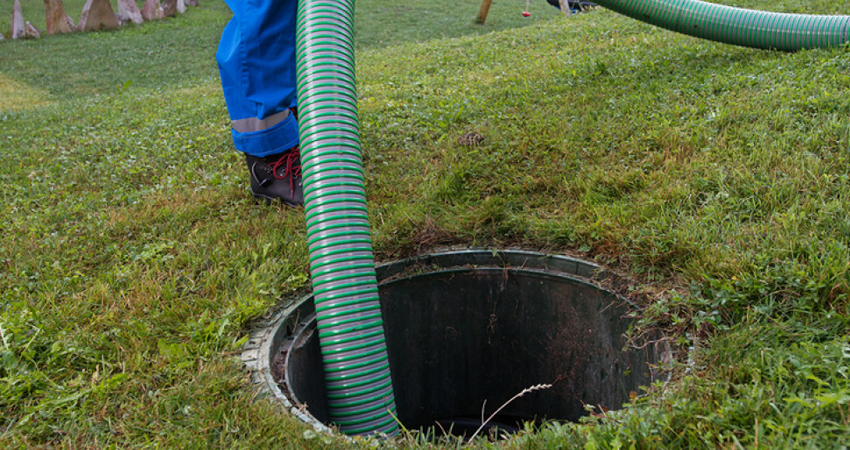
Septic Tank Maintenance Inspection and Pumping
Every three-to-five years homeowners should call a septic service professional to inspect their septic tanks. During this window of time household septic tanks should also be pumped. Systems with electrical float switches, pumps, or mechanical components need annual inspections. In such cases a service contract can be used to cover the inspection of mechanized parts.
The frequency of septic pumping depends on four factors:
- Household size
- Total wastewater generated
- Volume of solids in wastewater
- Septic tank size
The larger any of these four factors are, the greater the frequency of pumping.
Service Provider Data
A septic cleaning company will inspect your property for leaks and examines how much residue must be cleaned out of a septic tank.
Make sure to record when and what kind of repair and inspection work your service provider undertook. Such records will allow you to better know when your septic tank should next be fixed and what kind of work it requires. Future tank pumpings can be ascertained by tracking the sludge and scum levels found by a provider. In his or her service report providers should note completed repairs and tank conditions. Suggested repairs should be undertaken by a septic tank repair expert.
A T-shaped outlet on each septic tank impedes sludge and scum from escaping the tank and contaminating the drainfield area. A tank must be pumped if the scum layer is within six inches of the bottom of the outlet or if the top layer is within 12 inches of the top of the outlet.
Homeowners can find local service professionals through a septic locator on the website for The National Onsite Wastewater Recycling Association (NOWRA).
Water Efficiency
Individuals in a typical single-family home use nearly 70 gallons per day. Leaky or running toilets waste as much as 200 gallons of water per day.
The destination for all household water running through pipes is the septic system—conserved water minimizes septic system usage. Septic systems operate better and avoid failure when water is used efficiently.
The following are tips for economizing household water usage:
- Toilets account for 25 to 30 percent of household water use. Older toilets generally contain 3.5- to 5-gallon reservoirs, while newer, high-efficiency toilets use 1.6 gallons of water or less per flush. Replacing older toilets with high-efficiency models can minimize the quantity of water entering a septic system.
- Faucet aerators, high-efficiency showerheads, and shower flow restrictors all reduce water usage.
- Small loads of laundry need much less water and energy than large loads. Selecting a proper load size on a washing machine will reduce water waste. If such an option doesn’t exist on a machine then only full loads of laundry should be washed.
Washing small loads of laundry throughout the week necessitates less water than a large daily wash once a week. Large washes can harm septic systems by preventing them from having enough time to treat waste. This can flood a drainfield.
Compared to standard models, washing machines with an Energy Star label use 35 percent less energy and 50 percent less water. Energy Star appliances in general save energy and water.
Proper Waste Disposal
Every item that goes through a toilet, garbage disposal, sink, shower, or bath, ends up in a septic system. Mindfulness concerning such items can make an enormous difference in a septic system’s operation and maintenance.
- Toilets
Only human waste and toilet paper should go down a toilet. The following items are not to be flushed:
- Cooking grease or oil
- Non-flushable wipes, such as baby wipes or other wet wipes
- Photographic solutions
- Feminine hygiene products
- Condoms
- Dental floss
- Diapers
- Cigarette butts
- Coffee grounds
- Cat litter
- Paper towels
- Pharmaceuticals
- Household chemicals like gasoline, oil, pesticides, antifreeze, and paint or paint thinners
Sinks
Small organisms collect in septic systems and digest household waste, treating and reducing them in the process. These organisms, however, can be easily exterminated by toxins. The following are ways to make sure toxins do not enter a septic tank from a kitchen sink, bathtub, or utility sink:
- Chemical drain openers should not be used for clogs. Boiling water or a drain snake should be used instead.
- Avoid pouring cooking oil or grease down the drain.
- Fully protect your drain from oil-based paints, solvents, or large volumes of toxic cleaners. Only pour latex paint waste down a drain sparingly.
- Minimize garbage disposal usage. Disposal units induce fats, grease, and solids to enter septic tanks and clog drainfields. Best for a septic system is no disposal unit at all.
